I recently celebrated my second anniversary at G2, and it got me thinking back to my first few days here. Like most new hires, I felt a mix of excitement and nerves — eager to hit the ground running but overwhelmed by the sheer amount of information coming my way. Thankfully, the onboarding process was seamless, and I felt right at home within no time.
That experience made me realize just how crucial onboarding is, not just for setting up employees for success but for making them feel welcomed and valued from day one. It got me wondering: What tools are out there to help HR teams deliver that kind of experience at scale?
So, I decided to dive in and explore G2 reviews of some of the best onboarding software available. Over several weeks, I explored 20-plus onboarding solutions designed to simplify everything from paperwork to training to team introductions. In this listicle, I share the nine tools that stood out to me, their unique features, pros and cons, and why they might just transform how your organization approaches onboarding. Let's get into it!
9 best onboarding software for 2025: My top picks
- Rippling: Best for automated new hire setup with unified IT and HR
Automates the provisioning of devices, software access, and payroll enrollment simultaneously, streamlining the entire hiring and IT lifecycle. (flexible pricing)
- BambooHR: Best for personalized onboarding and employee experience
Provides a self-service platform for new hires to complete paperwork, access training, and engage with the company culture. (flexible pricing)
- HiBob HRIS: Best for collaborative workflows and setting early goals
Uses a clean, social-media-style interface to facilitate cross-team introductions, goal alignment, and cultural integration. (flexible pricing)
- Gusto: Best for simplified payroll and HR document management
Automates federal and state tax filings, benefits enrollment, and document e-signing, making compliance and new-hire paperwork management effortless. ($40/mo)
- Paylocity: Best for strategic HR management with performance analytics
Offers a comprehensive HCM suite that connects onboarding data with talent management and performance reviews for strategic workforce planning. (flexible pricing)
- RUN Powered by ADP: Best for combined payroll and HR self-service
Focuses on small business efficiency by simplifying payroll processing, tax compliance, and new-hire reporting in a single, reliable system. (flexible pricing)
- Deel: Best for compliant international hiring and contract management
Provides an all-in-one platform for EOR services, contracts, and payroll, ensuring full legal compliance. ($29 per employee/mo)
- JobDiva: Best for tracking and managing new hires from recruitment onward
Offers robust ATS features that ensure a smooth transition from candidate management to HR onboarding workflows. (not publicly available)
- Paycom: Best for unified employee setup and efficient time tracking
Centralizes all employee data from onboarding through payroll, benefits, and time management, minimizing duplicates and improving data accuracy. (not publicly available)
* These onboarding solutions are top-rated in their category, according to G2's Winter 2025 Grid Reports. I’ve also added their monthly pricing to make comparisons easier for you.
9 best onboarding software: My honest review
Onboarding is more than just filling out forms or completing checklists. It’s about creating an experience that makes new employees feel supported and confident from the start. The best HR onboarding software helps HR professionals automate repetitive tasks like sending offer letters, collecting e-signatures, and setting up IT accounts. With the right tool, it’s also easy to set up personalized workflows and ensure that every new hire gets the right resources, training, and introductions at the right time.
How did I find and evaluate the best employee onboarding software?
To put this list together, I worked closely with our HR and talent management teams, exploring a variety of onboarding platforms and evaluating their features, benefits, challenges, and overall value. I referenced G2’s Grid Report to see how these platforms compare to each other. I also used artificial intelligence to analyze hundreds of product reviews on G2, uncovering what other HR professionals like and dislike about these tools.My goal was to find software that saves you time, ensures compliance, and makes a lasting first impression — and I believe you’ll find that value here.
Attributes I think every onboarding software should have
When I started evaluating reviews for onboarding platforms, I knew I needed clear criteria to separate the best from the rest. Below are the seven key features I considered, which you, too, should look into when choosing onboarding solutions.
- Automation of repetitive tasks: One of the first things I looked for was how well the software could handle everyday tasks like sending out offer letters, scheduling reminders, and sending updates without manual effort. With a tool that automates these repetitive tasks, HR teams can focus on building relationships with new hires rather than chasing down paperwork.
- Customization for workflows and roles: Not every onboarding process is one-size-fits-all. I wanted to find tools that'll let HR teams create custom workflows tailored to specific roles, departments, or even seniority levels. For instance, a marketing manager and a software developer shouldn't have identical onboarding journeys. So, I looked for tools that can adjust tasks, training modules, and timelines to meet individual needs.
- Integrations with HR tech stack: A standalone tool isn't enough. It has to work well with other tools, too. I checked if the platforms easily integrated with human resources information systems (HRIS), payroll systems, compensation management software, and standard communication tools like Slack or Microsoft Teams.
- Progress tracking and analytics: HR teams need visibility into how onboarding is going, so I prioritized software with dashboards that show progress at a glance. Whether it's tracking document submissions, completed training sessions, or IT setups, the best onboarding solutions keep everything organized. Bonus points for platforms that offer analytics to help HR teams spot bottlenecks and improve their processes over time.
- Scalability for future growth: While doing my research, I quickly realized that your onboarding needs today might look very different a few years down the line. So, I researched how well each tool scales with growing teams and changing requirements. The right tool can handle everything from onboarding a single employee to rolling out workflows for entire departments.
- Employee experience features: I appreciate tools that include features like pre-boarding portals, interactive welcome messages, and engaging training modules to focus on the new hire's experience. Some platforms even gamify onboarding with quizzes and milestones, making it easier and more fun for employees to get up to speed.
- HR team’s feedback: Of course, I had to consider what people who use these tools daily think about them. I collaborated with our HR team to understand their real challenges and the impact these tools have on their workflows. Their insights gave me a clearer picture of which features genuinely make a difference and which might look good on paper.
I considered all these factors while evaluating more than 20 onboarding tools. I focused on evaluating how effectively they could save HR teams time by enhancing the onboarding experience and simplifying processes using the abovementioned features.
Beyond these essentials, I prioritized tools with intuitive dashboards for tracking progress, real-time analytics for actionable insights, and interactive pre-boarding portals to engage new hires early. After extensive evaluations and comparisons, I narrowed the list to the 9 best onboarding software that best met my criteria.
To be included in the onboarding software category, a product must:
- Facilitate communication between employer and employee before the first day of work
- Track all forms and paperwork needed for the onboarding process
- Offer task tracking for new-hire activities such as training or new-hire events
*This data was pulled from G2 in 2025. Some reviews may have been edited for clarity.
1. Rippling: Best for automated new hire setup with unified IT and HR
Based on my review of G2 user feedback, Rippling is frequently praised for its ability to automate HR processes, making it easier to manage everything from onboarding to payroll and benefits all in one platform. It has a satisfaction score of 99 on G2.
A standout feature that I’ve seen get a lot of love is the onboarding workflow. Users appreciate how quickly they can configure necessary tasks, such as setting up accounts, allocating equipment, and ensuring compliance checks. The integration with third-party tools like Slack and Google Workspace is often highlighted, as it automates steps and reduces the need for manual intervention.
G2 users consistently mention how much they value the centralized dashboard. Having everything in one place — from employee benefits to payroll management — is often considered a huge time-saver. This integration is particularly valuable for businesses experiencing rapid growth, as it eliminates the need to toggle between multiple systems, something many users call out as a significant benefit.
From what I’ve seen, payroll processing is another area where Rippling stands out in G2 reviews. Many users highlight the platform’s ability to handle payroll across different countries while tracking compliance with tax regulations. Instant discrepancy alerts seem to be a major point of praise, as users view this as crucial for maintaining accuracy in global workforces.
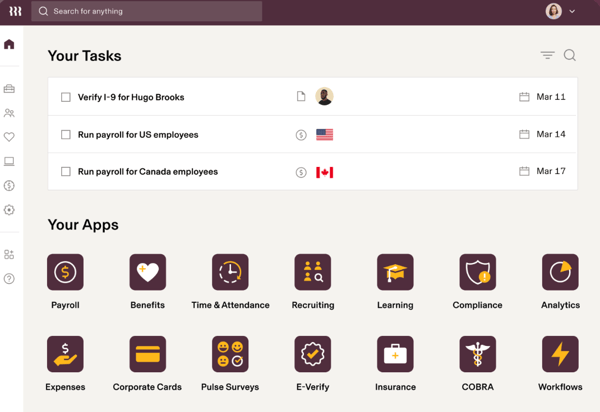
However, G2 reviewers noted that the desktop platform delivers the most comprehensive functionality, while the mobile app is intentionally streamlined for essential on-the-go access. This approach benefits teams that primarily operate from desktops and use mobile for quick updates or monitoring, offering focus and simplicity rather than feature overload.
Some G2 users mentioned that syncing can occasionally take longer when large data volumes or multiple integrations are in play. This reflects the platform’s prioritization of accuracy and secure data handling, providing consistency across systems even when real-time updates are not immediately critical.
What I like about Rippling:
- I’ve noticed that the mobile app’s limited features are often seen as a step down from the desktop platform, with users frequently needing to switch to a desktop for tasks that should be mobile-friendly.
- Many users on G2 point out that configuring advanced integrations can be challenging, especially without step-by-step guidance, which could overwhelm less tech-savvy users.
What G2 users like about Rippling:
"As a user, what I like best about Rippling is its ease of use on both desktop and mobile. I use it every week, and the platform is well-organized and intuitive, making it simple to find what you need. Setting up an employee account was also quick and easy. It offers a variety of features, such as performance reviews, W-2 forms, time-off requests, pay stubs, and a vacation calendar — all in one place. The reminders for tasks are also very helpful. Plus, the payday GIFs always put me in a great mood!"
- Rippling Review, Olga G.
What I dislike about Rippling:
- I’ve noticed that the mobile app’s limited features are often seen as a step down from the desktop platform, with G2 users frequently needing to switch to a desktop for tasks that should be mobile-friendly.
- Many users on G2 point out that configuring advanced integrations can be challenging, especially without step-by-step guidance, which could overwhelm less tech-savvy users.
What G2 users dislike about Rippling:
"The only thing I dislike is that sometimes the notification system can feel a bit overwhelming, especially when reminders for tasks or updates come through frequently. It's not a major issue, but streamlining those notifications or giving more control over them would improve the experience."
- Rippling Review, Christopher C.
2. BambooHR: Best for personalized onboarding and employee experience
Based on my review of G2 user feedback, BambooHR is often praised as a solid choice for small to mid-sized businesses aiming to streamline their HR processes. G2 users frequently highlight its clean and user-friendly interface, which makes it easy to navigate, even for those without a technical background. One common theme in reviews is that the platform's simplicity eliminates confusion, allowing teams to get started with minimal onboarding effort.
I’ve noticed that the electronic signature feature stands out positively in G2 reviews. Users appreciate how it simplifies document management, including NDAs and tax forms. Sending, tracking, and storing paperwork can be done with just a few clicks, saving time and providing a secure, eco-friendly alternative to traditional paper methods. This feature is a favorite among those looking to enhance efficiency.
Looking at the broader review trends, customer support consistently gets strong praise. G2 users often mention how responsive and knowledgeable the support team is, which is especially valuable for first-time users. The quick, actionable solutions they provide seem to be a major highlight for many HR teams.
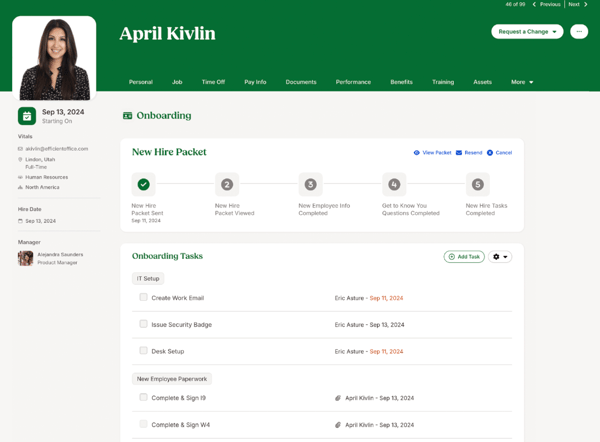
G2 reviewers mentioned that BambooHR’s pre-built reports are well-suited for standard onboarding needs, though teams seeking highly tailored or role-specific insights may find fewer native customization options. This design works best for organizations that prefer ready-to-use reporting templates and value simplicity over complex configuration.
While BambooHR’s default dashboard provides a clean, guided experience ideal for straightforward onboarding tracking, teams managing broader HR functions or unique KPIs may view its streamlined design as less adaptable. This offers an opening for organizations to integrate complementary analytics tools or customize existing widgets for deeper visibility into specific metrics.
Finally, G2 reviewers noted that periodic updates occasionally adjust workflows or interfaces, particularly during high-activity periods like onboarding. These updates are typically designed to enhance functionality and maintain security, though teams in time-sensitive cycles may prefer scheduling around release windows.
What I like about BambooHR:
- The platform’s clean and straightforward design is frequently praised, making it easy for teams without extensive tech expertise to access and use essential HR tools effectively.
- I’ve come across multiple reviews highlighting BambooHR's support team for their timely and effective assistance, which users consider a significant advantage.
What G2 users like about BambooHR:
"BambooHR is a highly user-friendly and intuitive HR system. The platform is designed for ease of use, making it simple to update and manage both candidate and employee records efficiently. It is an excellent tool for tracking and organizing HR processes. Additionally, BambooHR is easy to implement and offers great virtual event features, enhancing employee engagement and collaboration."
- BambooHR Review, Aicha B.
What I dislike about BambooHR :
- Based on my review of G2 user feedback, generating reports during peak usage tends to take longer than expected, which can be uncomfortable for users dealing with time-sensitive tasks.
- Many G2 reviewers mention that BambooHR’s limited integrations with niche tools lead to some manual work.
What G2 users dislike about BambooHR :
"The only drawback we've experienced is with the time clock feature. It can be a bit glitchy at times, failing to properly clock employees in or out, which results in a lot of manual corrections. While the location stamp feature is a great tool, it has been acting up lately, inaccurately stamping employees at locations different from where they actually are. Hopefully, these issues can be resolved soon because the feature itself has so much potential."
- BambooHR Review, Judy R.
3. HiBob HRIS: Best for collaborative workflows and setting early goals
Based on my review of G2 user feedback, HiBob HRIS is often praised for its modern and intuitive design that makes workforce management more efficient and engaging. As per G2 Data, it is widely adopted in the mid-market segment, with 80% of users coming from that segment, the highest among these tools.
A consistent theme in G2 reviews that I’ve noticed is the positive feedback regarding preboarding workflows.
Many users appreciate how these workflows help create a welcoming experience even before day one. One standout capability that I see getting a lot of praise is the ability to send preboarding packets, gather documents, and notify relevant teams, such as IT and managers, about their roles. G2 reviewers frequently mention how this proactive system helps eliminate last-minute chaos, setting the tone for a smooth onboarding process.
Another feature that G2 reviewers often highlight is the organizational chart tool, which is described as simple yet powerful. Users seem to really appreciate how it makes it easy to visualize team structures and adjust them as the company grows or changes. This feature is particularly valued during onboarding or when team shifts occur, as it helps clearly communicate corporate hierarchies.
The "shoutout" feature is another element that G2 reviewers consistently mention. It promotes team recognition and helps foster connections among employees, especially new hires. Many users appreciate the integration with tools like Slack and MS Teams, which allows these shoutouts to be visible to the entire team, making the onboarding process feel more inclusive and engaging.
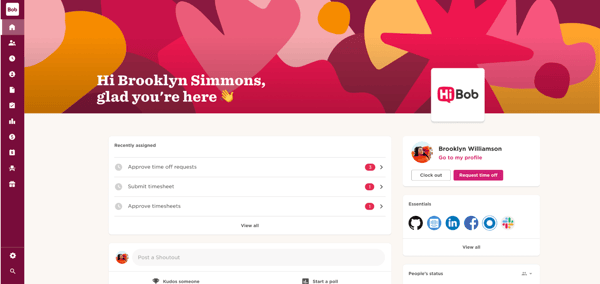
From what I’ve seen in G2 reviews, BambooHR’s structure emphasizes simplicity and clarity, which works well for organizations with straightforward time-off policies. However, several reviewers mentioned that teams with more complex or layered leave structures sometimes find the platform’s flexibility limiting. Customizing leave types or approval workflows can require additional configuration, making it less convenient for businesses managing diverse or evolving time-off scenarios.
Building on that, multiple reviewers also noted that BambooHR’s configurability can feel somewhat restricted in certain areas. While the platform is designed to reduce complexity, users managing specialized workflows or compliance-driven processes occasionally struggle to tailor features to specific business needs. One example that surfaced often involved tenure-based leave policies, which required manual workarounds to implement.
In addition, G2 users mentioned that bulk updates present another area where there’s room for refinement. Adjusting data across multiple records can involve extra steps that aren’t immediately intuitive, which can slow down larger teams working through frequent changes.
What I like about HiBob HRIS:
- HiBob's employee self-service options are highly appreciated, allowing employees to independently update their details, check pay stubs, or request time off, empowering them and reducing administrative burden.
- I’ve noticed that customizable workflows receive positive feedback for being easy to configure, providing a level of adaptability that many other tools lack.
What G2 users like about HiBob HRIS:
"The ticket system is excellent; help is prompt, and issues are consistently resolved. The community is also very supportive — if we can't solve something on our own, there is always assistance available. I have never experienced this level of support with any other software I've used. I also appreciate how Bob operates, including its layout and features, as well as its ease of use. As a software, it's not only very useful but also enjoyable, which encourages frequent usage."
- HiBob HRIS Review, Maria C.
What I dislike about HiBob HRIS:
- Many users on G2 mention that delayed or repetitive alerts can create confusion, with multiple notifications for the same task becoming a little distracting.
- I’ve come across G2 user's feedback expressing a desire for easier bulk editing, as making changes across multiple employee records at once can be cumbersome.
What G2 users dislike about HiBob HRIS:
"Leave accrual options are surprisingly rigid and don't cater well to country-specific leave types (Australian Long Service Leave or NZ Leave Act complexities). It would be great to have the country leave legislation built in/pre-loaded as a standard."
- HiBob HRIS Review, Kate G.
Related: Want to evaluate if your hiring efforts are working out? Learn how to calculate recruitment ROI.
4. Gusto: Best for simplified payroll and HR document management
Based on my review of G2 user feedback, Gusto is often praised for making payroll and HR management as painless as possible, with many users appreciating its ability to streamline complex tasks. G2 Data indicates that it is widely used in small businesses, with 93% of users reporting adoption.
One feature that stands out is the custom onboarding checklists. G2 reviewers frequently highlight how easy it is to assign tasks like signing offer letters, submitting tax forms, and enrolling in benefits. It even scores the highest on this list for ease of use on G2 at 96%. These checklists can be tailored to specific roles, ensuring that the onboarding process feels personal and efficient, especially when managing multiple new hires simultaneously. Many users mention that tracking task progress provides peace of mind during these busy times.
Another standout capability, according to users, is the integration between Gusto and applicant tracking system (ATS). Many G2 reviewers appreciate how seamlessly candidate data can be imported into Gusto, ensuring a smooth transition from hiring to onboarding. This integration significantly reduces time and errors, which is often highlighted as a huge benefit for businesses looking to manage new hire data seamlessly.
Something G2 reviewers seem to really appreciate is software provisioning automation. The ability to automatically assign roles and grant access to necessary tools for new hires, as well as revoke access for departing employees, is frequently mentioned. This feature is especially valuable for hybrid and remote teams, where maintaining security and simplifying access management is critical.
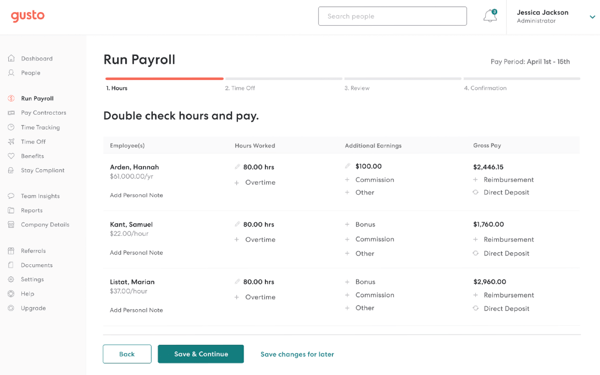
While Gusto receives strong praise overall, some G2 reviewers noted that its reporting tools are designed around simplicity and standardization. The platform’s pre-built reports work well for most payroll needs, but teams seeking highly customized or analytics-heavy insights may find themselves exporting data to external tools for deeper analysis.
Reviewers also mentioned occasional performance hiccups, such as minor loading delays or brief errors when updating employee information. These moments tend to occur infrequently but highlight opportunities for ongoing optimization as Gusto continues to expand its capabilities.
Finally, several G2 users observed that Gusto’s workflows are best suited for straightforward payroll setups. Companies managing a mix of contractors and full-time employees noted that handling complex pay structures requires additional steps and manual configuration.
What I like about Gusto:
- Gusto’s pricing is often highlighted as a great fit for small and medium-sized businesses, offering robust features at a competitive cost.
- I’ve noticed that pay stubs are frequently praised for their clarity, with the breakdown of deductions and benefits helping to avoid confusion among employees.
What G2 users like about Gusto:
"Gusto provides our small company with a complete/comprehensive HR solution that doesn't break the bank. It seamlessly aids us in handling everything from onboarding new employees to facilitating annual reviews and internal promotions while also acting as a hub for the important daily needs of employees, such as scheduling PTO, managing expense reports, and accessing company data/forms. We love that our people can access their documents from the web or the Gusto app, as that flexibility is clutch in a multi-generational office! The implementation team at Gusto did a great job of educating our account administrators on the ins and outs of the program and continuing to support us after the go-live date. We've been using Gusto for about 2 years now and have found that the software continues to inspire us by being intuitive and easy to use, so much so that none of our employees required training to get up and running. Even better, we have not yet encountered even one issue utilizing this software. It truly is a win for everyone on our team!"
- Gusto Review, Brooke B.
What I dislike about Gusto:
- I’ve noticed in G2 reviews that state-specific tax compliance can be a challenge, especially for businesses operating across multiple jurisdictions.
- According to G2 reviewers, Gusto's reporting capabilities could use some improvement, as the current options may not meet the needs of businesses looking for more tailored insights into their payroll and HR data.
What G2 users dislike about Gusto:
"As amazing as the customer support team is, sometimes it's hard to reach someone quickly. The mobile experience of the website could use some improvements. As a business owner who's often on the go, I do need to be able to complete tasks on a mobile device. "
- Gusto Review, Danielle L.
5. Paylocity: Best for strategic HR management with performance analytics
Based on my review of G2 user feedback, Paylocity is widely regarded as a comprehensive HR and payroll solution that integrates a wide range of tools into one platform, making workforce management more manageable for businesses of all sizes.
A consistent theme in G2 reviews that I’ve noticed is how compliance management is made easy with built-in tools for handling federal and state regulations. G2 users frequently appreciate how the platform seamlessly collects and stores essential forms and withholding documents. One feature that stands out is the ability to initiate background checks directly within Paylocity, which eliminates the need for third-party tools. Automated reminders and task lists further help ensure nothing falls through the cracks, making compliance management significantly less stressful for HR teams.
Another commonly appreciated element is centralized data management. Many reviewers highlight how easy it is to access and organize employee information. Whether it’s reviewing onboarding progress or pulling documents for an audit, having everything in one place saves time and minimizes the chances of errors, which is a recurring positive theme in reviews.
I’ve also seen a lot of praise for employee feedback tools, specifically the 30-, 60-, and 90-day surveys. G2 reviewers often mention how these tools offer valuable insights into how well new hires are settling into their roles. The simplicity of reviewing responses is also a plus, helping HR teams spot and address concerns early to foster a more supportive work environment.
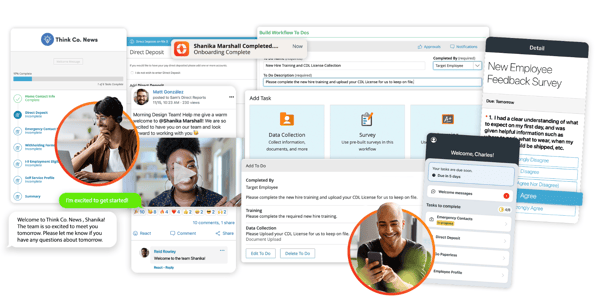
While Paylocity earns strong marks overall, some G2 reviewers noted that navigating the platform can require multiple steps to reach specific features. The payroll processing workflow, for instance, involves several screens and verifications that can feel time-intensive for users managing frequent pay runs.
Reviewers also mentioned that the interface itself can feel layered, with certain features and settings tucked into deeper menus. This structure benefits teams that value detailed control and robust configuration, though it may take new users time to develop familiarity with the layout.
Additionally, feedback around the time and labor module highlights another area where users see room for refinement. G2 reviewers shared that tracking timecards for exempt and non-exempt employees can feel less intuitive, especially when identifying missing submissions. Even so, many noted that these processes reflect Paylocity’s emphasis on compliance accuracy, a trade-off that ensures precise tracking once workflows are properly established.
What I like about Paylocity:
- One feature that I see getting a lot of praise is Paylocity's comprehensive HR module, which covers everything from payroll to benefits management and compliance, making it an all-in-one solution for HR teams.
- I’ve noticed that the implementation process is often highlighted as straightforward, with many users mentioning that Paylocity's knowledgeable support team helps ensure everything runs smoothly from day one.
What G2 users like about Paylocity:
"Paylocity has all the features that a complete human resources and timekeeping system should have. It is very useful for tasks such as onboarding, evaluations, timesheet filling, and processing payroll. All these features are self-explanatory, and the tutorials work well."
- Paylocity Review, Eva K.
What I dislike about Paylocity:
- I’ve come across feedback mentioning that tailoring certain features to fit specific organizational needs can be challenging, with G2 users needing to use workarounds for tasks like creating customized reports or workflows, adding unnecessary complexity.
- Many G2 reviewers point out that certain settings and features are buried deep within menus, which can create a hurdle for new users or teams looking to maximize productivity.
What G2 users dislike about Paylocity:
"Customer support can be tricky. We've had several dedicated account representatives in three years, with widely varying levels of expertise. We often receive different information between sources. When there are bugs/issues, it can take weeks to months to resolve."
- Paylocity Review, Haley T.
6. RUN Powered by ADP: Best for combined payroll and HR self-service
Based on my review of G2 user feedback, RUN Powered by ADP is often described as a well-rounded solution for managing payroll and onboarding, offering a range of features that streamline these processes without overwhelming users.
One feature that I frequently see getting a lot of praise is how effortlessly payroll setup is handled. G2 reviewers highlight how the platform simplifies tasks like generating pay stubs, calculating taxes, and filing state-specific returns, all with minimal input. This level of automation is frequently appreciated by teams that lack dedicated payroll specialists, saving time and reducing manual effort.
Another standout capability, according to G2 users, is the platform’s intuitive design. Many reviewers mention how the layout feels natural and user-friendly, even when managing more complex tasks like compliance tracking or generating detailed reports. The clear step-by-step guidance helps users complete these tasks efficiently without unnecessary frustration or delays.
Something G2 reviewers seem to really appreciate is the self-service onboarding tools. Multiple reviewers note how the platform allows new hires to manage their own onboarding, including entering personal information, completing tax forms, and setting up direct deposits. This feature not only reduces the administrative burden on HR teams but also gives employees a sense of control, which is highly valued by users.
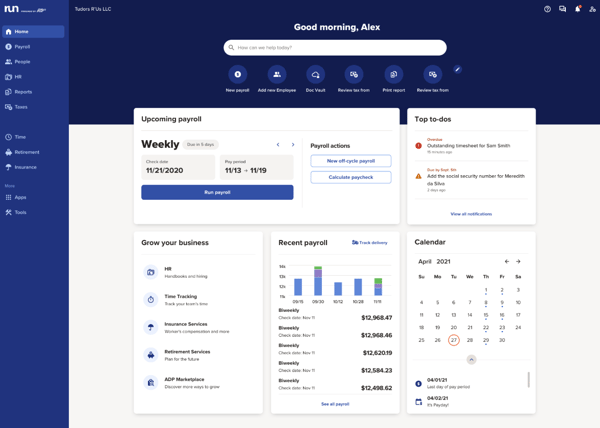
G2 reviewers mentioned that customization is designed to balance simplicity with structure. Setting up basic workflows is quick and intuitive, but teams looking to build deeply tailored onboarding experiences for specific roles or departments may find additional configuration steps necessary.
In addition, G2 users highlighted that the mobile app is optimized for accessibility and quick task management rather than complex configuration. It’s well-suited for employees who need to complete essential actions on the go, but those who prefer managing full onboarding workflows from mobile devices may find the feature set more restricted than expected.
Finally, some reviewers mentioned that the platform’s frequent promotion of additional services can occasionally feel intrusive, particularly for teams focused on using core functionalities. However, others recognized this as part of a broader effort to surface integrations and premium features that expand operational value for organizations ready to scale.
What I like about RUN Powered by ADP:
- The layout and navigation are frequently praised for being user-friendly, allowing first-time users to quickly locate the necessary tools, making the overall experience smooth and efficient.
- I’ve seen multiple users express being impressed with how RUN facilitates payroll tasks, particularly with generating pay stubs and filing state-specific taxes with minimal effort.
What G2 users like about RUN Powered by ADP:
"One of my favorite features of RUN is its capability to support a digital onboarding process. This functionality has allowed us to transition to a more streamlined approach for bringing new employees on board. As a result, we have reduced the potential for errors and made the onboarding experience clearer and easier to manage."
- RUN Powered by ADP Review, Kennedy H.
What I dislike about RUN Powered by ADP:
- I’ve seen in G2 reviews that the timekeeping system often receives objections for being underwhelming, lacking advanced features for tracking hours and approvals.
- According to G2 user feedback, the upselling of additional products is often seen as excessive and unnecessary.
What G2 users dislike about RUN Powered by ADP:
"Sometimes, the cost can be too high, especially for clients that are new to payroll or just getting started."
- RUN Powered by ADP Review, Rania A.
7. Deel: Best for compliant international hiring and contract management
Based on my review of G2 user feedback, Deel is highly regarded for its ability to manage global onboarding with a strong focus on compliance and security. Many G2 reviewers appreciate how it offers excellent tools for handling international teams, particularly when dealing with complex regulations across different countries.
A consistent theme in G2 reviews that I’ve noticed is Deel's employer of record (EOR) tool. Users often highlight how it streamlines the onboarding process by managing contracts and ensuring compliance, even in countries with stringent local requirements. For example, G2 reviewers mention that Deel can easily handle the onboarding of new hires in countries like Germany, significantly reducing the workload for HR teams.
Another feature that I see getting a lot of praise is localized workflows. Reviewers frequently mention how Deel automatically accounts for region-specific requirements, such as documentation and benefits, ensuring compliance without additional manual effort. This is a key benefit that helps HR teams navigate international complexities with ease.
From what I’ve seen, Deel’s security features are also a highlight for many users. G2 reviewers often call out the platform's strong encryption and secure payment systems, noting that these features provide confidence when managing sensitive employee data. With compliance and data protection built in, it’s easier for businesses to focus on creating a smooth and efficient onboarding process.
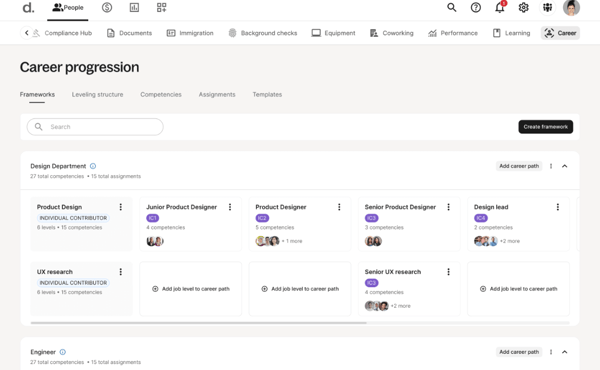
G2 reviewers said that its workflows are intentionally structured to ensure accuracy and consistency across regions. This approach supports compliance and standardization but can feel rigid to teams seeking high customization. Several users noted that tailoring contract terms or adding unique benefits requires additional steps, an understandable trade-off for maintaining reliable, compliant operations at scale.
Reviewers also mentioned that syncing across multiple regions can occasionally introduce short delays. These moments tend to occur when processing large volumes of payroll and onboarding data simultaneously, particularly across different time zones.
Finally, feedback on reporting tools suggests room for expansion. G2 reviewers observed that while the reports are accurate and structured, the dashboards focus more on data clarity than visual interactivity.
What I like about Deel:
- One standout capability, according to users, is Deel's ready-to-use templates tailored to each country's legal requirements, which saves significant time on manual work.
- Deel's step-by-step guidance for onboarding remote employees is frequently highlighted as invaluable, ensuring no critical steps are overlooked during the process.
What G2 users like about Deel:
"What I like best about Deel is its seamless user experience and strong focus on global compliance. The platform simplifies hiring and onboarding for remote teams, ensuring adherence to local labor laws in different countries. Its flexible payment options also allow employers to pay team members in multiple currencies, enhancing overall satisfaction. This combination of user-friendly design, compliance assurance, and payment flexibility makes Deel an invaluable tool for managing a global workforce."
- Deel Review, Kelly M.
What I dislike about Deel:
- G2 users note that incorrect tax rates are occasionally flagged by the system, requiring manual adjustments during payroll processing, which adds extra work.
- Many G2 users point out the absence of a centralized dashboard for tracking compliance and onboarding progress across regions, making it more cumbersome to compare regional data.
What G2 users dislike about Deel:
“I dislike the 3-5 business days it takes to process transactions for an international account. If there's an emergency, I would have to wait 5 days to receive the money from my account to my international bank.”
- Deel Review, Feleecia K.
8. JobDiva: Best for tracking and managing new hires from recruitment onward
Based on my review of G2 user feedback, JobDiva is widely appreciated as an all-in-one solution for applicant tracking and onboarding management. Many users value how it centralizes recruitment data in one place, making it easy to access and manage, which is particularly beneficial for organizations that deal with large candidate volumes. It has the most enterprise users on this list, at 33% according to G2 Data.
Something G2 reviewers seem to really appreciate is integration with job boards and internal systems. According to feedback I gathered from users, this integration makes candidate matching incredibly efficient. For example, users frequently mention how JobDiva automatically identifies top candidates based on skills and availability, significantly reducing manual effort and saving time.
Another standout capability, according to users, is reporting tools. Reviewers often highlight how easy it is to generate reports on candidate pipelines, onboarding progress, and time-to-hire metrics. The customizable options are especially praised, allowing HR teams to focus on the most critical insights, which is a major benefit for streamlining decision-making.
One commonly appreciated element is JobDiva's robust support for contract employees. G2 users frequently note how the platform efficiently tracks contract statuses, renewal deadlines, and compliance documentation. This greatly reduces the usual back-and-forth associated with managing contract employees, making it easier to stay on top of critical tasks.
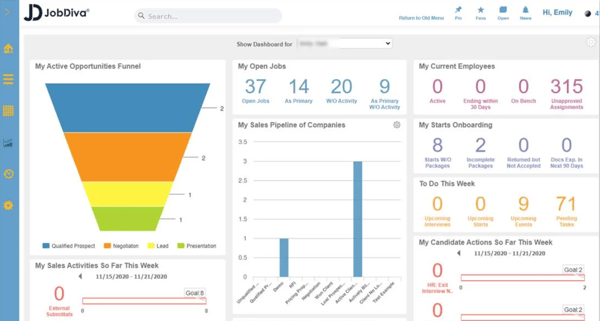
Across G2 reviews, many users highlighted that JobDiva’s robust data management capabilities can occasionally result in slower performance during large-scale updates. This tends to occur when the platform processes extensive hiring data or multiple records simultaneously.
Reviewers also mentioned that JobDiva’s interface can feel complex at first, particularly for users new to the system. The platform’s breadth of functionality comes with a learning curve, but many teams view this as an opportunity to develop deeper platform fluency over time. Once users complete initial training or guided onboarding, the navigation and workflows tend to become far more intuitive.
In addition, feedback from G2 users points to bulk editing as an area with room for improvement. While JobDiva offers strong automation tools, updating large candidate pools can require multiple steps, which may feel time-consuming for recruiters managing massive datasets.
What I like about JobDiva:
- One feature that I see getting a lot of praise is JobDiva’s integration with multiple job boards, which allows users to manage applications in one place, making candidate sourcing more efficient.
- I’ve noticed that JobDiva’s ability to track contract lifecycles is frequently highlighted, helping users stay on top of renewals and compliance, which reduces the risk of oversight.
What G2 users like about JobDiva:
"This tool allows us to integrate all job boards in one place, effectively managing the entire lifecycle from recruitment and interviews to onboarding and the contract cycle for candidates. It is a robust and user-friendly ATS that organizes candidate data efficiently. Moreover, it enables recruiters to easily check the onboarding and contract status and maintain connections with candidates. JobDiva utilizes advanced algorithms to match candidates with job requirements efficiently. I have been using this tool for over three years, and it has greatly assisted me in my daily activities. It streamlines time tracking and payroll integration for contractors and employees. Portal integration, email tracking for candidates, and an easy-to-use interface make it one of the best ATS solutions available in the market."
- JobDiva Review, Rohan M.
What I dislike about JobDiva:
- I’ve seen multiple G2 reviewers mention that the interface can be challenging to navigate, particularly for first-time users, which may delay the onboarding of new team members.
- Many G2 users point out that processing bulk updates can sometimes take longer than expected, leading to workflow interruptions on the platform.
What G2 users dislike about JobDiva:
"JobDiva can be tricky at first because it has many features, and it is confusing and time-consuming to search for anything. New users may have a hard time learning about how to use it. The tool also sometimes slows down when dealing with a lot of candidates or jobs. And when I want to update the status or details of many candidates at once, it doesn't easily facilitate such updates, so I have to do them all individually, which is extremely time-consuming."
- JobDiva Review, Abhishek N.
9. Paycom: Best for unified employee setup and efficient time tracking
Based on my review of G2 user feedback, Paycom is highly regarded for its seamless integration of onboarding and employee development tools. Many G2 users appreciate how it blends self-service features with integrated learning modules, making HR processes more efficient and empowering employees to take control of their information.
One feature that I see getting a lot of praise is the self-service tools. G2 reviewers often highlight how employees can independently update personal details, access documents, and enroll in benefits, which significantly reduces communication bottlenecks. As a result, HR teams can focus more on strategic priorities rather than day-to-day administrative tasks.
Another aspect frequently mentioned in positive reviews is the learning modules. According to feedback I gathered from G2 users, the ability to assign role-specific training directly through Paycom and track progress or provide real-time feedback is a standout capability. Reviewers note that this helps set new hires up for success right from the start.
From what I’ve seen, the onboarding process is often described as cohesive and efficient. G2 users appreciate the centralized checklists and automated compliance features that simplify managing multiple hires. This helps HR teams stay organized, especially when handling large volumes of new employees.
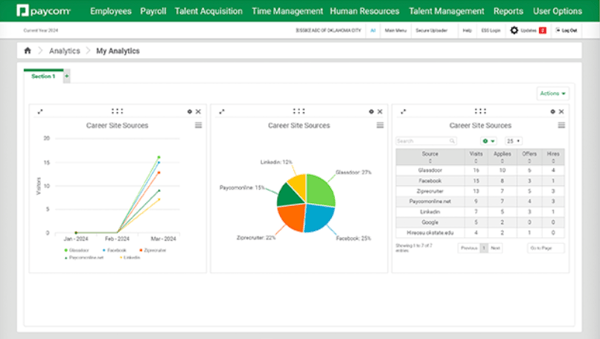
The setup process, particularly for department-specific courses, is seen as detailed and step-driven, an approach that benefits teams aiming for structured learning paths but may require more upfront configuration. Once established, these workflows tend to provide a strong foundation for scalable, repeatable training programs.
Reviewers also highlighted that integrations sometimes require manual adjustments to ensure smooth data flow across connected systems. Syncing with tools like performance management platforms may need minor configuration, which some users find time-intensive. Still, this flexibility allows teams to fine-tune integrations to fit their specific HR tech stack rather than relying on rigid, one-size-fits-all connections.
In addition, feedback from G2 users suggests that managing a large number of hires can be demanding during periods of rapid growth. Scaling the platform often involves additional setup and oversight, but many reviewers noted that these efforts ultimately strengthen process consistency and data accuracy.
What I like about Paycom:
- The integration of training into onboarding workflows is frequently praised for being smooth and effective, allowing employees to complete courses at their own pace, making the experience both flexible and engaging.
- I’ve noticed that the self-service portal is often highlighted for its intuitiveness, enabling employees to access everything they need without requiring constant HR assistance.
What G2 users like about Paycom:
"Paycom's customer support is so good. They actually reach out to me more than I have to reach out to them. When I do need help, I call the support team and get immediate assistance. They are also constantly improving their software, without breaking things that work in the process. I couldn't be happier with my Paycom experience."
- Paycom Review, Kathryn B.
What I dislike about Paycom:
- Setting up onboarding workflows for larger teams took more time than necessary for some G2 users. Careful attention was required to ensure that all tasks were assigned correctly.
- Additionally, Paycom's limited integration with third-party tools was unsuitable for some reviewers, resulting in extra manual work to align data between systems.
What G2 users dislike about Paycom:
"I feel like the applicant process is a bit clumsy and not as intuitive as I've seen in other programs. I also don't like how difficult it is to find an offer letter once an applicant has been onboarded. It seems like that should be one of the documents in their file, but the only place it can be found is on their application, even once they're a current employee."
- Paycom Review, Kaitlyn L.

Frequently asked questions about new hire onboarding software
Got more questions? Read on for the answers.
Q1. What is the best onboarding software for employees?
There's no one-size-fits-all tool; the best tool depends on your requirements and goals. Rippling and BambooHR are two tools that have been praised for supporting new hires. Rippling helps you simplify workflow and connects easily with other tools, while BambooHR focuses on creating a smooth, engaging experience with personalized onboarding plans. Both are good options for helping employees hit the ground running.
Q2. What is the best onboarding software for small businesses?
For small businesses, Gusto and HiBob are popular options. Gusto keeps things simple with payroll and HR tools that are easy to set up, while HiBob offers a balance of affordability and features that grow with your team. Both help you make a big impression without a big budget.
Q3. How much does onboarding software cost?
Onboarding software can cost anywhere from a few dollars to hundreds of dollars. However, many tools offer flexible pricing, so you can find one that perfectly fits your needs and budget.
Q4. How secure is onboarding software for sensitive employee data?
Most good onboarding platforms take security seriously. They use encryption and strict access controls and follow regulations like the General Data Protection Regulation (GDPR) to ensure your data is safe.
Q5. Which onboarding software unifies IT provisioning with HR workflows?
Rippling is the best solution for this. It automates both HR workflows (payroll, documents) and IT provisioning (device setup, software access/SSO) in a single platform, eliminating manual handoffs between departments for new hires.
Q6. What is the best platform for compliant global hiring and EOR management?
Deel is the top platform for this use case. It provides an all-in-one solution for Employer of Record services, compliant international contracts, and local payroll processing across several countries.
Q7. Which tool best integrates US payroll, tax filing, and HR document management?
Gusto and RUN Powered by ADP excel here. Both platforms are built to simplify US compliance by automatically handling federal and state tax filings, benefits administration, and document e-signing for small to mid-sized businesses.
Q8. How to choose the best onboarding software
To find the right onboarding software, start by defining your goals and must-have features like automation, integrations, and scalability. Set a realistic budget that balances cost and value, and check for compliance and data security. Read verified user reviews, test free demos with your HR team, and measure ROI through time saved, smoother onboarding, and happier new hires.
Hop onboard!
Finding the right onboarding software can transform how new hires connect with your company and settle into their roles. As I explored and evaluated these nine best onboarding tools, one thing stood out: the best onboarding software goes beyond automating tasks; it creates a meaningful and memorable experience.
From user-friendly interfaces to seamless integrations that ensure smooth processes and unique features designed to engage employees, each tool on this list has something special to offer.
Whether you're aiming to reduce paperwork or make your new hires feel genuinely welcomed, the right platform should align with your company's goals and culture. I hope this guide gives you the confidence to choose a tool that checks all the boxes and helps you set the stage for lasting success.
Sales is a skill everyone should master. Explore the best sales and onboarding tools to get your team performing at their best.














.png)



.png)